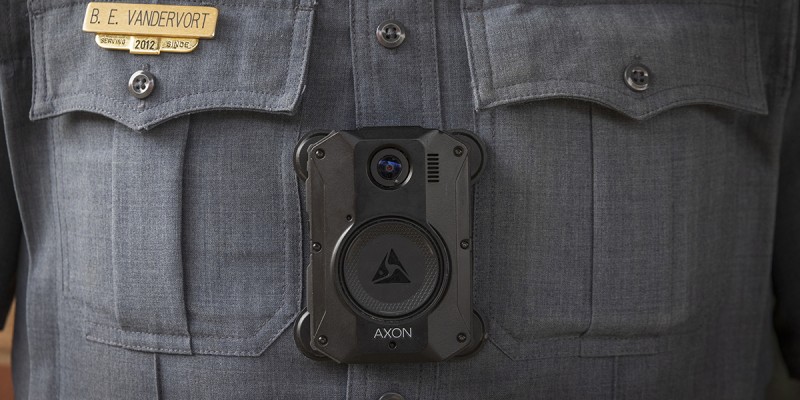Binghamton University Police using body-worn cameras

A car speeds down Glenn G. Bartle Drive, but is pulled over by Binghamton University Police. A body-worn camera is quickly turned on as an officer gets out of the vehicle, and an audio and video record of the stop is underway.
Binghamton University Police (UPD) joined with at least 16 other SUNY schools this fall when body-worn cameras were implemented following a recommendation by the Campus Citizen Review Board. Body-worn cameras are now in use for all service calls received by UPD.
“The Campus Citizen Review Board welcomes the implementation of its recommendation to obtain and use body-worn cameras,” said CCRB co-chairs Karen Jones, vice president for diversity, equity and inclusion; and Matthew Johnson, professor of psychology. “The CCRB recently met with Interim Chief Rossie to get an update on the body-worn cameras. The board appreciated the way in which the recommendation has been implemented and believes that consistent use of body-worn cameras will promote accountability, trust and communication among the Binghamton University campus community and the Binghamton University Police Department.”
“The cameras provide accountability for people on both sides, so now we have an unbiased record of what happened,” said Interim Police Chief Matthew Rossie. “Our officers have been trained on how to use, view and submit the videos [into storage], and every officer has a camera.”
The CCRB recommendation was timely, as the campus had been investigating acquiring body-worn cameras to improve and provide additional transparency to community policing and enforcement efforts, said University Police Investigator Mark Silverio. “The equipment, including the cameras and storage space, was ordered in fall 2021 and was expected to be delivered by Thanksgiving,” he said. “But it was delayed by supply chain issues and we finally received the cameras in May. Once they arrived, a Florida police officer familiar with the system we are using came here for an all-day training of our trainers.
“We then did a two-hour in-service training with each of our officers on how to use the cameras and upload the recordings,” Silverio said.
University Police are following a SUNY policy for implementation. Though that policy is still in draft form, it is guiding the general orders that officers are bound by. “The officers turn the camera on when they arrive at a scene and turn it off when a call is completed,” Rossie said. “It’s very obvious when they’re on, so this is not covert surveillance.”
Once a recording has ended, officers use an app on their phones to quickly tag it with a case number, give it a title, such as traffic stop, and assign it a retention category to determine how long the recording will be stored, Silverio said. In all, it takes an officer about 30 seconds after a call to complete the tagging. Once the camera is docked at the end of an officer’s shift, the recording automatically downloads to an off-site storage system.
“We store everything that’s recorded, even if it was just going to unlock a door; anything that might be of value whether it’s traffic stops or criminal complaints,” Silverio said. “There are different retention periods depending on the call. The standard is 180 days, civil issues are kept for three years, felonies for 10 years and misdemeanors for five years. Some things, like a fatal car accident, would be kept forever.”
“Our initial cost for hardware and training was $64,000,” said Vice President for Operations JoAnn Navarro. “There will be an annual cost of about $28,000 a year, mostly for storage.”
The recordings are automatically purged once they meet the assigned retention schedule, but with the cameras in use for just a few months, the University is already using 871 gigabytes of storage, Silverio said.
The storage system used by UPD includes an audit trail, so if someone views an uploaded video, it is logged. “For example, a supervisor can review a recording to ensure it has been categorized correctly and we have built-in spot reviews in our general orders,” Silverio said.
“I’m happy with the body-worn cameras and the supervisors are as well,” Silverio added. “It’s gone incredibly smoothly with no pushback. Our officers are happy to have bodycams and we haven’t heard any complaints. It’s beneficial

